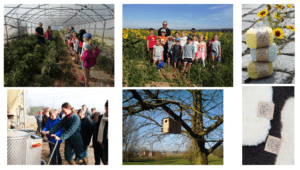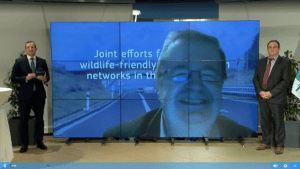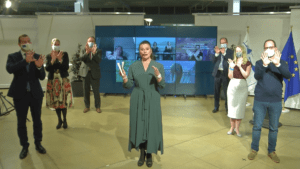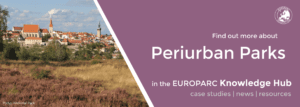How can we communicate to, with and for farmers: Workshop outcomes
© Agriculture_European Commission
EUROPARC’s Online Conference 2020 included 8 thematic workshops on diverse topics related to practice and capacity building in Protected Areas. In case you have not attended, or want to remind yourself of their outcomes, a series of articles summarises the content of some of these workshops.
From European level, to field experience
In the workshop presentations, insights from two different levels were discussed. First, Stefania Petrosillo, EUROPARC Policy Officer in Brussels, shared the relevant EU Policies that were focused on agriculture and Protected Areas. These included the Green Deal, the Farm to Fork Strategy and the Common Agriculture Policy. There is both a challenge in the increasing pressures on agriculture and an opportunity in the increasing attention for the environment.
Baptiste Hottekiet, Director of the Pays des Collines Nature Park and Representative of the Federation of Nature Parks of Wallonie-Belgium was the second presenter. He explained how Protected Areas can facilitate communication with farmers. This can lead to cooperation that is beneficial for both the Protected Areas and the farmers. For example, the farmer image towards consumers can improve substantially.
Since we accompany farmers in their work for a better sustainable and profitable agriculture, we have each year more and more farmers who participate to our nature’s projects. It’s a long-term process but it works.
The ways Pays des Collines Nature Park communicated and cooperated with farmers varied greatly. Farmers were involved in decision making processes and farmers markets with local products and educational activities were organised.

Presentation Slide – Baptiste Hottekiet
What is needed
So where do these insights leave us? In the presentations and discussions, it was evident that communication is key, both with farmers and at an EU level. By using the language of Farmers and understanding what they need, you can start a dialogue. This eventually leads to cooperation that is beneficial to both the farmer and the Protected Area.
Therefore, knowledge on how to communicate is needed in the case of farmers and the case of EU Policy. This can be provided through the creation of ‘tools’ for farmers and the exchange of knowledge between Protected Areas on this subject.
EUROPARC Federation can serve as a forum for capacity building, inspiration and sharing of best practices. By also keeping close contact with the EU institutions, Protected Areas will also stay well-represented in agricultural policies. Read for example the Position Paper on European Protected Areas and Sustainable agriculture.
For more information, please do not hesitate to contact Stefania Petrosillo, Policy Officer at EUROPARC Federation or to download the workshop presentations below.
Download the presentations:
- Case study: How Walloon Nature Parks promote a better communication with farmers?, by Baptiste Hottekiet (Director of NP Pays des Collines, BE) – download
- Presentation: The EU new strategies: Biodiversity 2030 and Farm To Fork, by Stefania Petrosillo (EUROPARC Policy Officer) – download
More info on sustainable agriculture: go here
Europe’s Biodiversity is under pressure
Parc naturel régional de Brière (FR) © Photo Jean Pierre Saliou
With the start of the EU Green week, the European Environmental Agency (EEA) has published its rapport “State of Nature in EU”.
The European Environmental Agency’s report “State of Nature in EU” is a comprehensive “health check” of nature in the European Union. It reports on the status and trends in 2013 -2018 of species and habitat types protected by the Birds and Habitats Directives. EU member states are required to report every six years to gauge the state of nature in the EU.
The results of the past 5 years show that nature is under pressure and that there is still a lot of work that needs to be done.
The report demonstrated a continuing decline of protected habitats and species. This is mostly caused by intensive agriculture, urbanization, unsustainable forestry activities and changes to freshwater habitats. Pollution of air, water and soil also impacts habitats, as well as climate change, over-exploitation of animals through illegal harvesting and untenable hunting and fishing. Additionally, member states are not prioritizing nature protection enough. So, as our president Ignace Schops said with the publication of the Global Biodiversity Outlook 5, it’s “high time to turn tide!“.
To make a lasting change, EEA Director Hans Bruyninckx says we need to drastically change the way we produce our food, manage our forests and build our cities. Additionally, we need to better execute nature protection, restoration and set more ambitious climate targets. EUROPARC knows that the answer lays within nature, and that protecting our valuable ecosystems is not only necessary, but also effective: improvement are recorded in bird populations in Natura 2000 areas.
Improvement of Natura 2000 areas
Although a decline is visible across almost all populations and habitats, some positive news can be found in the report as well. The amount and size of Natura 2000 areas has increased in the last six years, causing the EU to reach global targets. Currently 18% of the land and almost 10% of marine area is protected. However, we are still a long ways of the targets in the EU “Green Deal”, where the goals is to legally protect 30% of the land.
Time for action
The message is clear: if we continue along this path we will destroy valuable habitats and species. EUROPARC urges EU member states to priorities nature protection and restoration. We do not need more “paper parks”,
Europe needs well-managed Protected Areas as places where nature can thrive.
EUROPARC’s members are ready to be key players in reaching the EU targets on biodiversity, not just as “far away places”, but also in greening urban areas or by realizing sustainable agriculture practices. The European Commission wants to “bring nature back into our lives” – Europe’s Protected Areas, when supported politically and financially, are ready to deliver.
Want to find best practice examples of all that EUROPARC’s members are doing? Then have a look at our “Knowledge Hub“
Get to know the Natura 2000 Award winners!
The winners of the European Natura 2000 Award were announced at a livestreamed Ceremony on the 14th October 2020. Get to know the winners!
Natura 2000 Award Ceremony
This year, the Natura 2000 Awards reached its 5th edition, and after a thoughtful revision of the 79 eligible applications from 26 countries, 27 finalists were selected for the final round. Among them were several EUROPARC members, such as:
- German Association for Nature Protection (NABU) – Gransee with the project Diving for conservation;
- The Thuringian Ministry of Environment, Energy and Conservation leading the project Network of Natura 2000 stations in Thuringia;
- Cascais Ambiente with the project Quinta do Pisão Nature Park.
After an external evaluation of each application was carried out, a dedicated jury had the difficult task to decide which of the applicants, clustered in five different categories, were the winners of the European Natura 2000 Awards.

Some of the finalists of the N2000 Award
This year, and following the format of many of the events that took place since the start of the COVID 19 pandemic, the Natura 2000 Award Ceremony was hosted online. However, the Ceremony did not lack any of the ingredients that an Award Ceremony has: nerves and excitement from the side of the participants, which were present through their screens and presented one by one from by the moderator Suyin Aerts, and a friendly environment and enthusiasm jointly created by the European Commissioner for Environment, Oceans and Fisheries, Virginijus Sinkevičius, and the Jury members that announced each of the winners:
In the COMMUNICATION category, the Award went to:
Eau la la!!! Eco-tips for sea and shore! – France, implemented by Lannion-Trégor Communauté, Guingamp-Paimpol Agglomération and PETR du Pays de Guingamp.
In the SOCIO-ECONOMIC BENEFITS category, the Award went to:
Pro-Biodiversidad: Shepherds as biodiversity conservators in Natura 2000 – Spain, led by the Fundación para la Conservación del Quebrantahuesos with the collaboration of local farmers.
In the CONSERVATION category, the Award went to:
Using underwater inventories for the conservation of marine areas in Finland – Finland, led by the Ministry of the Environment and the Finnish Environment Institute (SYKE).
In the RECONCILING INTERESTS/ PERCEPTIONS category, the Award went to:
Ten keys to co-ownership for nature projects – Belgium, implemented in Belgium by the Agentschap voor Natuur en Bos, De Vlaamse Waterweg, Gemeente Kruibeke and vzw Kruibeeks Natuurbehoud.
In the CROSS-BORDER COOPERATION AND NETWORKING category, the Award went to:
Joint efforts for safe and wildlife-friendly transportation networks in the Carpathians – Czech Republic, led by the Nature Conservation Agency of the Czech Republic, with partners in Romania, Austria, Hungary, Czech Republic, Slovakia, and Ukraine.

Representative from the Nature Conservation Agency of the Czech Republic receiving the Award
The leading institution, Nature Conservation Agency of the Czech Republic, is a EUROPARC member.
The project is based on a multidisciplinary cooperation through cross-border networking to share experiences and best practices, and stimulate discussion amongst all relevant sectors in order to improve and develop safe and environmentally-friendly road and rail transport solutions.
And finally, the European Citizen’s Award, which is granted based on a public voting that took place from June to September 2020, was announced. For this award, a total of almost 45,000 votes were casted among all the finalists, regardless of the category they were included in. As a result, the prestigious
EUROPEAN CITIZEN’S AWARD went to:
Partnership for protection of Bulgarian old-growth forests in Natura 2000 – Bulgaria, led by the Executive Forest Agency (EFA), the Ministry of Agriculture, Food and Forestry, Bulgaria, WWF Bulgaria, the Association of Parks in Bulgaria and the Balkani Wildlife Society. This project helped to reconcile conflicting interests over the designation of forest-related Natura 2000 sites.

The winners of the Natura 2000 Award
About the Natura 2000 Awards
The Natura 2000 Awards was first launched in 2014 in order to recognise successful stories of conservation across the EU and raise awareness about one of Europe’s outstanding achievements – the Natura 2000 network of protected areas.

Grenoble as Green Capital 2022
Grenoble - made by Nicole Herrero
Last week, the Green Capital 2022 title was awarded to the city of Grenoble. This city is home to one of our Periurban Park members.
Green Capital Award
The European Green Capital and Green Leaf award winners were announced in a ceremony on the 8th of October in Lisbon, the current Green Capital. Commissioner Virginijus Sinkevicius awarded Grenoble as the Green Capital of 2022. The Green Leaf award, for cities with less than 100.000 inhabitants went to Gabrovo in Bulgaria and Lappeenranta in Finland.
The winners and finalists of the green city awards have proven to be resilient and shown that, even in the most difficult circumstances like this year’s, rapid changes are possible (Commissioner Virginijus Sinkevicius).
An expert jury looked at four different cities and twelve indicators. Grenoble was awarded the Green Capital title because it scored exceptionally high in climate mitigation and adaptation. The city was granted 350.000 euros to start a ‘green year’ full of sustainable initiatives and events. Éric Piolle, the Mayor of Grenoble stated that:
We all need to adapt our way of life and I am sure that being a European Green Capital will help us to go further.
Grenoble Alpes Metropole
Grenoble is a city surounded by nature, and home to one of our members, the periurban park Grenoble Alpes Métropole. Six open recreational areas, together forming 593 ha (195 ha are under the control of “Grenoble Alpes Métropole”) surround the city and are connected to this initiative, allowing 404.000 “city dwellers” to get in touch with nature. These areas are now preserved and reserved for recreational and educational activities such as outdoor sports and are important for the natural, historical and cultural heritage of the area. Without a doubt, these parks played a key role in the green cities’ success.
We congratulate the City of Grenoble and hope to see more of both the city and the surrounding natural areas in the following years!
